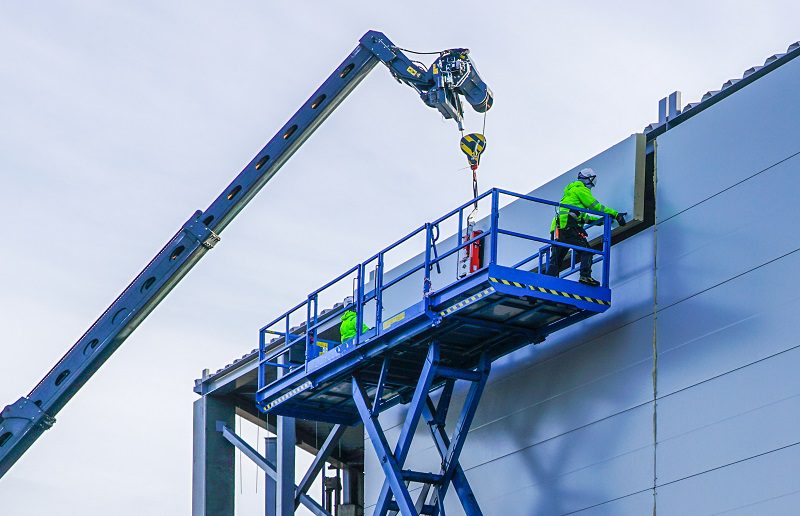Best Practices for Operating Scissor Lifts with Fall Protection

Ensuring Worker Safety: Best Practices for Operating Scissor Lifts with Fall Protection in the Workplace
Scissor lifts are indispensable tools in various industries, providing elevated access for maintenance, construction, and other tasks. However, working at height presents inherent risks, making fall protection essential for safeguarding the well-being of workers. Employers must prioritize safety by implementing comprehensive measures to mitigate fall hazards when operating scissor lifts. In this article, we’ll explore the importance of fall protection in scissor lift operations and discuss best practices for employers to ensure the safety of their workers in the workplace.
Understanding the Risks of Scissor Lift Operations:
- Fall Hazards:
- Working at height exposes workers to the risk of falls, which can result in serious injuries or fatalities. Falls from scissor lifts can occur due to various factors, including unstable surfaces, equipment malfunctions, improper use, and lack of fall protection measures.
- Regulatory Requirements:
- Regulatory authorities, such as OSHA in the United States and WorkSafeBC in Canada, have established standards and regulations governing fall protection in the workplace, including requirements specific to scissor lift operations. Employers are obligated to comply with these regulations to ensure the safety of their workers.
Best Practices for Operating Scissor Lifts with Fall Protection for Ensuring Worker Safety:
- Conduct Comprehensive Risk Assessments:
- Before commencing scissor lift operations, employers should conduct thorough risk assessments to identify potential fall hazards and implement appropriate control measures. Factors to consider include working height, surface conditions, weather conditions, equipment condition, and task requirements.
- Provide Proper Training and Certification:
- Ensure that workers operating scissor lifts receive comprehensive training on safe operation practices, fall protection measures, and emergency procedures. Training should cover topics such as equipment inspection, stability assessment, fall arrest systems, and rescue procedures.
- Workers should be certified and competent in scissor lift operation, demonstrating proficiency in equipment controls, maneuvering techniques, and hazard recognition.
- Use Appropriate Fall Protection Equipment:
- Equip workers with appropriate fall protection equipment, including harnesses, lanyards, and anchor points, when operating scissor lifts at height. Fall arrest systems should be properly inspected, maintained, and worn by workers to prevent falls and minimize the risk of injury.
- Ensure that fall protection equipment is compatible with scissor lift operation and complies with relevant safety standards and regulations.
- Implement Engineering Controls:
- Implement engineering controls to minimize fall hazards and enhance worker safety during scissor lift operations. This may include installing guardrails, toe boards, and platform extensions to prevent falls from elevated platforms.
- Employers should also consider using self-retracting lifelines (SRLs) or secondary guardrails to provide additional fall protection for workers working at height.
- Maintain Equipment in Good Condition:
- Regularly inspect and maintain scissor lifts to ensure they are in safe working condition. Conduct pre-use inspections before each shift to check for any defects, malfunctions, or signs of wear that could compromise safety.
- Address any issues promptly and ensure that defective equipment is taken out of service until repairs are completed by qualified personnel.
- Establish Safe Work Practices:
- Develop and enforce safe work practices and procedures for scissor lift operations, including proper positioning of the lift, securement of tools and materials, and communication protocols between workers.
- Emphasize the importance of situational awareness, hazard recognition, and adherence to safety protocols to minimize the risk of accidents and injuries.
- Provide Adequate Supervision and Oversight:
- Assign a competent supervisor to oversee scissor lift operations and ensure compliance with safety procedures. Supervisors should monitor work activities, provide guidance to workers, and intervene in unsafe behaviors or conditions.
- Encourage open communication between workers and supervisors to address safety concerns, report hazards, and facilitate timely response and intervention.
In conclusion, ensuring the safety of workers when operating scissor lifts with fall protection in the workplace requires a multifaceted approach encompassing risk assessment, training, equipment, engineering controls, maintenance, safe work practices, supervision, and oversight. By implementing Best Practices for Operating Scissor Lifts with Fall Protection with comprehensive measures to mitigate fall hazards and promote a culture of safety, employers can protect the well-being of their workers and minimize the risk of falls and injuries during scissor lift operations. Prioritizing safety not only safeguards workers’ lives but also enhances productivity, morale, and overall organizational success.
Click here for an online scissor and aerial lift training program.
Categories
- Aerial Lift
- ATV Training
- Bear Awareness
- Chainsaw Training
- Confined Space
- Defensive Driving
- Forklift Training
- Lockout Tagout
- Online Safety Training
- Overhead Crane
- Pipeline Construction Safety Training
- Propane Handling
- Safety Training Benefits
- Scissor Lift
- Skid Steer Training
- Space Awareness
- TDG
- Telehandler Forklift
- Traffic Control
- Train the Trainer course
- Training Course
- Uncategorized
- WHMIS
- Workplace Harassment and Violence Preventiont
